Big Island Whale Watching Season A Guide
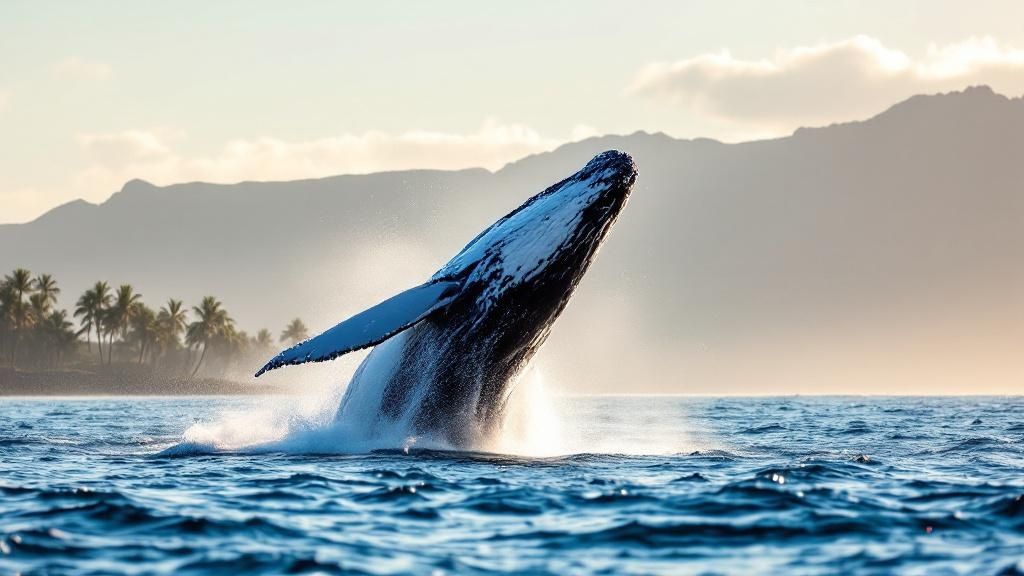
So, you want to see the whales. The quick answer is that the Big Island whale watching season really kicks off in December and runs through March. This is the magic window when thousands of humpback whales trade the frigid waters of Alaska for the warm, protected bays of Hawaii.
But it’s so much more than just a date on a calendar.
The Epic Journey That Brings Whales to Hawaii
Every winter, the ocean off the Big Island becomes the grand finale of one of nature's most incredible migrations. This isn't just a casual swim; it’s an instinct-driven odyssey. Imagine traveling 3,000 miles on an empty stomach—that's exactly what these humpbacks do, journeying from their Alaskan feeding grounds to the calm, welcoming waters of the Hawaiian Islands.
This isn't a vacation for them. It's a crucial, life-or-death chapter that defines the entire whale watching season here.
The whales make this massive trip for one reason: the next generation. They come here to breed, give birth, and nurse their newborn calves in a safe haven, far from the predators lurking in the cold northern seas.
Here’s a mind-blowing fact: for the entire time they're in Hawaii, the adult humpback whales don't eat a single thing. They survive purely on the fat reserves they built up during their summer feast in Alaska. Every powerful breach and tail slap you witness is fueled by sheer will and stored energy, which makes seeing them in action even more remarkable.
Why They Choose Hawaii's Waters
This migration is absolutely essential for the survival of the species. The warm, shallow waters around the Hawaiian Islands create the perfect nursery, and for a few key reasons:
- A Safe Nursery for Calves: Newborn whales don’t have the thick layer of blubber needed to survive Alaska’s icy temperatures. Hawaii is like a warm incubator, giving them a safe space to grow during their first vulnerable months.
- Courtship and Competition: This is also mating season. Males put on spectacular shows to compete for females, leading to some of the most dramatic surface behaviors you'll ever see—breaches, pectoral fin slaps, and intense competitions between pods.
- Learning the Ropes: While here, calves stick close to their mothers, learning vital survival skills. They need to get strong enough for the long, demanding swim back north when the season ends.
The rhythm of the Big Island whale watching season is completely tied to these natural cycles. The peak viewing times in late January and February happen for a reason—it’s when the highest concentration of whales is here for these critical life events.
Once you understand the why behind their journey, a whale watching tour transforms from just a sightseeing trip into something much deeper. You're not just watching whales; you're witnessing a timeless story of resilience, family, and survival.
To help you plan your own adventure, here's a quick look at how the whale activity changes month by month.
Big Island Whale Watching Season at a Glance
| Month | Whale Activity Level | Common Behaviors |
|---|---|---|
| December | Building | The first arrivals appear. You'll see adults, mostly males and females without calves. |
| January | High | Lots of activity! More whales arrive daily. Look for competitive pods and courtship behaviors. |
| February | Peak | The absolute best time. The highest number of whales are present, including new mother-calf pairs. |
| March | High, then declining | Still great viewing, especially for mothers and calves. Whales begin their journey back north late in the month. |
| April | Low | Most whales have left, but you might catch a few stragglers, often mothers and calves, heading north. |
As you can see, timing is everything. While you can spot whales from December through April, booking your trip for January or February gives you the absolute best shot at seeing the full spectacle.
Now that you know the best time to come, let's dive into what you can expect to see out on the water.
Finding the Best Time to See Whales
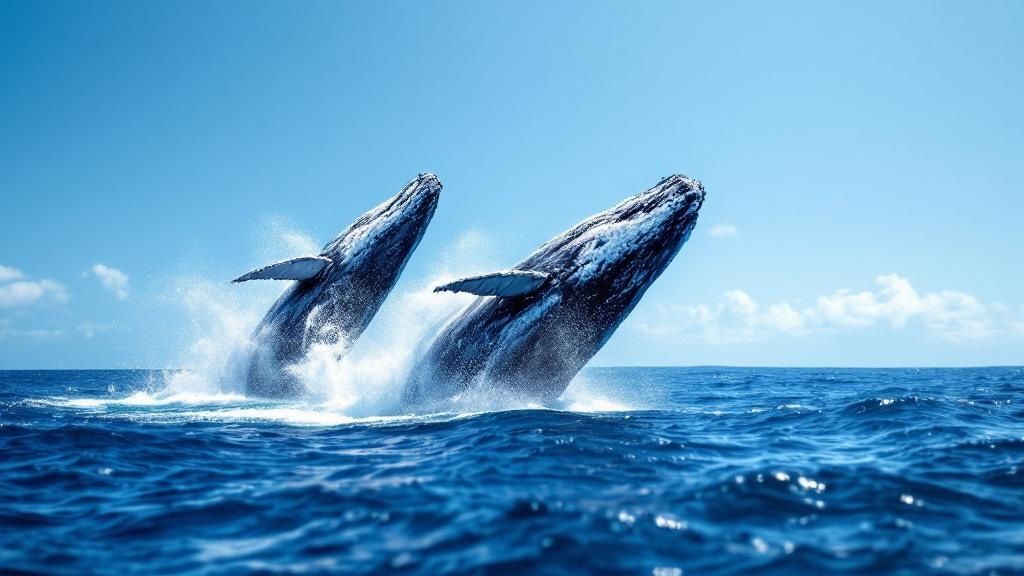
Timing is everything when you’re planning a whale watching trip. Sure, the official Big Island whale watching season runs from December through March, but what you’ll see on the water can change drastically from one month to the next. Think of it like a massive, ocean-wide festival—the crowd, the energy, and the main acts are always shifting.
Figuring out when to book your tour really comes down to what you hope to experience. Are you after the high-energy drama of competing males, or the quiet, touching moments between a mother and her newborn calf? Each phase of the season offers a completely different window into the lives of these incredible giants, and knowing the difference is the secret to an unforgettable trip.
Early Season Excitement (December – Early January)
The early season kicks off with the grand arrival. Starting in late November and picking up speed in December, the first humpback whales make their appearance after an epic journey from their Alaskan feeding grounds. These initial arrivals are typically the big, competitive adults, and they are ready to put on a show.
Picture a ballroom where the first guests are making a grand entrance, all vying for attention. This period is completely dominated by powerful males chasing after females, which translates into some of the most spectacular surface action you’ll ever see.
What can you expect?
- Competitive Pods: It’s common to see groups of males aggressively pursuing a single female. This creates a thrilling, and sometimes chaotic, spectacle right on the water's surface.
- Impressive Breaches: Whales will launch their entire 40-ton bodies out of the water in breathtaking displays of raw power.
- Loud Tail Slaps: A powerful form of communication, these massive slaps on the water echo across the ocean and can be heard from a surprising distance.
This part of the season is all about raw power and high-stakes drama. The total number of whales is still building, but the action you do see is incredibly intense and memorable.
Peak Season Prime Time (Late January – February)
If the early season is the arrival party, then peak season is the main event. By the time late January and February roll around, the waters off the Big Island have transformed into a bustling metropolis for humpback whales. This is when their population hits its absolute peak.
During this window, the number of sightings just skyrockets. On a good day, it’s not a question of if you'll see whales, but how many. The ocean feels truly alive, with spouts and splashes in every direction you look. The social dynamic changes, too. While the competitive behavior is still going strong, a heartwarming new element enters the scene: newborn calves.
This is the heart of calving season. The warm, protected waters of Hawaii provide the perfect nursery, and spotting a mother patiently guiding her curious, playful calf is an experience that will stick with you forever.
These "little" guys, weighing in at a whopping 2,000 pounds at birth, stick close to their moms. They’re just learning how to breathe, breach, and navigate the world, often with clumsy but utterly adorable results. Peak season gives you the best of both worlds—the drama of courtship combined with the tenderness of new families. For more on how the season unfolds across the islands, you can explore the full Hawaii whale season in our detailed guide.
Late Season Serenity (March – April)
As March arrives, the energy on the water starts to shift again. The festival is winding down, and many of the energetic adults have already started their long swim back north to Alaska. But the show is far from over.
The late season is really all about the moms and their growing calves. These pairs are usually the last to leave Hawaii, giving the babies extra time to pack on the blubber and strength needed for the tough journey ahead. It makes for a much more serene and nurturing viewing experience.
The pace is slower, the interactions are gentler, and the focus is squarely on that powerful bond between mother and child. You’ll often see moms patiently teaching their calves essential skills, offering a peaceful and profound glimpse into their world. While you might see fewer whales overall compared to February, the sightings are often more intimate and last longer, making March a fantastic choice for photographers or anyone hoping for a calmer, more reflective adventure.
The Best Places for Whale Watching on the Big Island
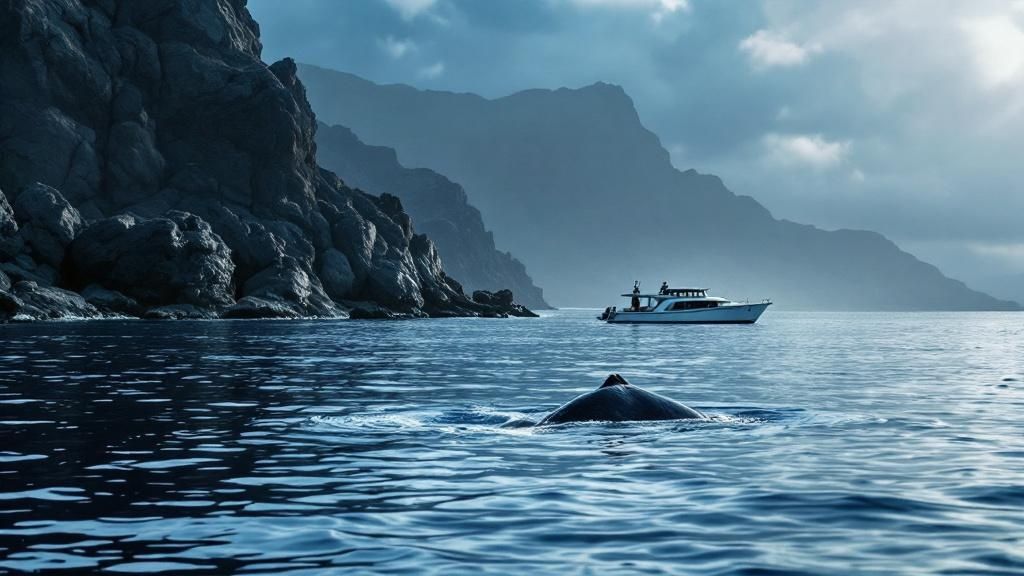
Alright, you know when to come for the Big Island whale watching season, but now for the million-dollar question: where do you go? Location is everything. Just like us, the whales have their favorite hangouts, and knowing where to look makes all the difference. Luckily, the Big Island serves up amazing views from both the water and the shore, with one stretch of coastline that’s in a league of its own.
Think of the Big Island’s western coast as a giant, protected nursery for humpback whales. The water here is calm, warm, and relatively shallow—the absolute perfect recipe for a mother whale to give birth and teach her new calf the ways of the ocean. This makes the entire area a magnet for whale activity from December clear through March.
The Kohala Coast: The Undisputed Hotspot
If there's one place that's the true epicenter of whale watching, it's the Kohala Coast on the northwestern edge of the island. This is the sweet spot, covering the waters from just north of Kailua-Kona all the way up to the town of Hawi. The island's geography creates a uniquely sheltered marine environment here, shielding it from the gusty winds and rough seas you might find elsewhere.
This natural protection is exactly why so many humpbacks gather here. It’s a safe haven where moms can rest and nurse their babies without fighting strong currents. What does that mean for you? A much higher concentration of whales, which seriously boosts your chances of having one of those jaw-dropping sightings.
It's no surprise that most boat tours, especially the ones leaving from Kawaihae and the Waikoloa resort area, head straight for these waters. The combination of calm seas and tons of whales just makes for a fantastic and comfortable day out on the ocean.
Kona Coast: A Hub of Adventure
Just a bit south of Kohala, the Kona Coast is another phenomenal zone for whale watching. Tours leaving from Kailua-Kona and Keauhou Bay have super quick access to the deep, productive waters where whales love to play.
One of the big perks here is convenience. You can easily hop on a morning whale watch and still have the rest of your day to explore everything else Kona has to offer. Plus, these trips often deliver more than just humpbacks. It's common to run into pods of playful spinner dolphins or even pilot whales, which adds a whole other layer of excitement to the trip.
The Big Island's reputation isn't just talk. During recent coordinated whale counts, observers on the Big Island spotted nearly 500 humpback whales right from the coastline—the highest number of any main Hawaiian island. You can dive into the amazing results from the Great Whale Count and see for yourself how the Big Island stands out.
Prime Locations for Shoreline Whale Watching
Don't have your sea legs? No worries at all. The Big Island has some of the best land-based whale watching in all of Hawaii. Seriously. With a good pair of binoculars and a bit of patience, you can see incredible breaches and tail slaps without ever setting foot on a boat. The trick is to find an elevated spot with a wide-open view of the ocean.
Here are a few of my go-to spots for watching from shore:
- Puukohola Heiau National Historic Site: The name literally means "hill of the whale," and it absolutely lives up to it. The visitor center area offers a breathtaking panoramic view over the very waters whales frequent.
- Lapakahi State Historical Park: This quiet, beautiful park along the North Kohala coast is another fantastic vantage point. The elevated shoreline gives you a clear line of sight for spotting spouts on the horizon.
- Kapaa Park: Tucked away just north of Hawi, this park is a local favorite. It’s a peaceful spot to pull up a chair and just scan the water.
A quick tip for watching from land: early mornings are often best. The sea is usually calmer, and you won't have to deal with as much glare from the sun. Grab your binoculars, find a comfy spot, and prepare to be amazed by the show unfolding just offshore.
How to Choose the Right Whale Watching Tour
Picking the right tour is every bit as important as choosing the right time of year. Believe me, not all boats are created equal, and the vessel you choose will absolutely shape your entire experience on the water.
What's perfect for a family with small kids is going to be completely different from what a thrill-seeking couple wants. It’s like picking a car for a road trip. The big, comfy van is great for the whole family, but the adventurous couple wants the zippy convertible. Your whale watching tour is no different. Your choice impacts everything from your view of the whales to how comfortable you are. So let's break down what you'll find along the Kona and Kohala coasts.
Comparing Big Island Whale Watching Tour Vessels
To help you decide, let's look at the most common types of tour boats. Each offers a completely different vibe and viewing experience, so think about what kind of day you're hoping for.
| Vessel Type | Best For | Pros | Cons |
|---|---|---|---|
| Large Catamaran | Families, first-timers, those prone to seasickness. | Super stable, onboard bathrooms & snacks, lots of space, great elevated views. | Can be crowded, less personal, feels further from the water. |
| Zodiac (Raft) | Adventurous couples, small groups, photographers. | Fast and exciting, eye-level views, small groups, gets to whales quickly. | Bumpy ride, no bathrooms or shade, not for young kids or those with back issues. |
| Private Charter | Special occasions, serious photographers, groups wanting total control. | You set the schedule, total privacy, customized experience. | Most expensive option. |
Ultimately, the boat you're on sets the stage for your entire whale encounter. Whether you prefer the steady platform of a catamaran or the adventurous rush of a Zodiac, choosing wisely is the first step toward an unforgettable day.
Questions to Ask Before You Book
A little homework before you click "book" can make all the difference. Here are a few essential questions to ask any tour company you're considering.
A great tour is more than just a boat ride; it’s an educational experience. The best operators hire marine naturalists who can interpret whale behavior, share fascinating facts, and answer your questions, transforming your trip from simple sightseeing into a deep learning adventure.
Here’s a quick checklist to run through:
- Is there a marine naturalist on board? This is a huge one. Their expertise adds so much depth to the trip.
- What happens if we don't see whales? Wildlife is never guaranteed, but good companies often have a "rain check" policy for another tour.
- How close do you get? Responsible tours will proudly state that they follow federal law, staying at least 100 yards away to protect the animals.
- What's the group size? This gives you a real sense of how crowded—or intimate—the experience will feel.
While the humpbacks are the stars of the show, you never know what else you might see. This chart breaks down how often different whale species are spotted.
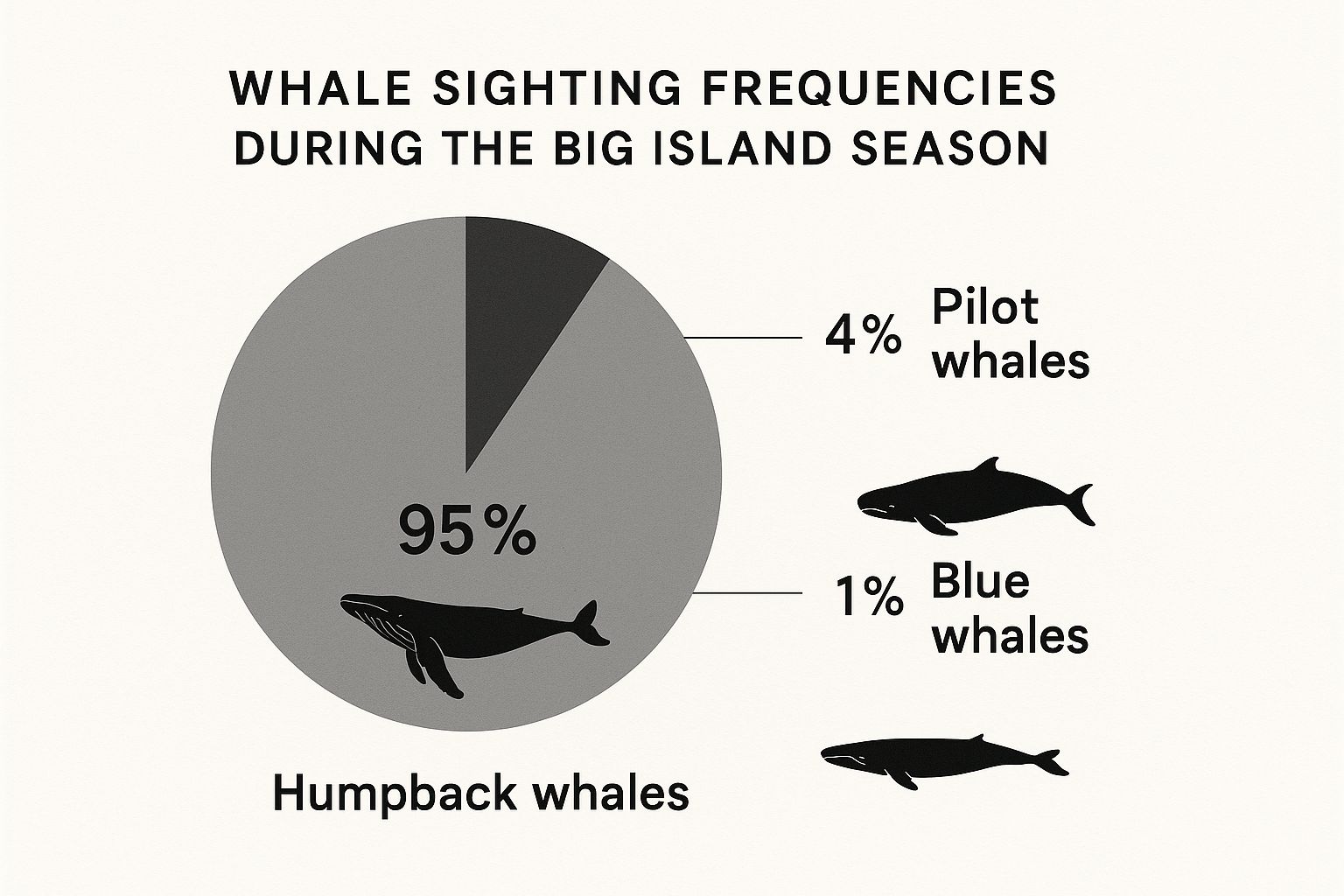
As you can see, humpback whales absolutely dominate the sightings at a staggering 95%. There's no question who the main event is during the winter months! For those looking to see them up close, exploring options for whale watching tours from Kona is a great place to start your planning. You can also check out curated lists like the Top 5 Whale Watching Kona Big Island Tours to find a highly-rated operator.
Pro Tips for an Unforgettable Experience
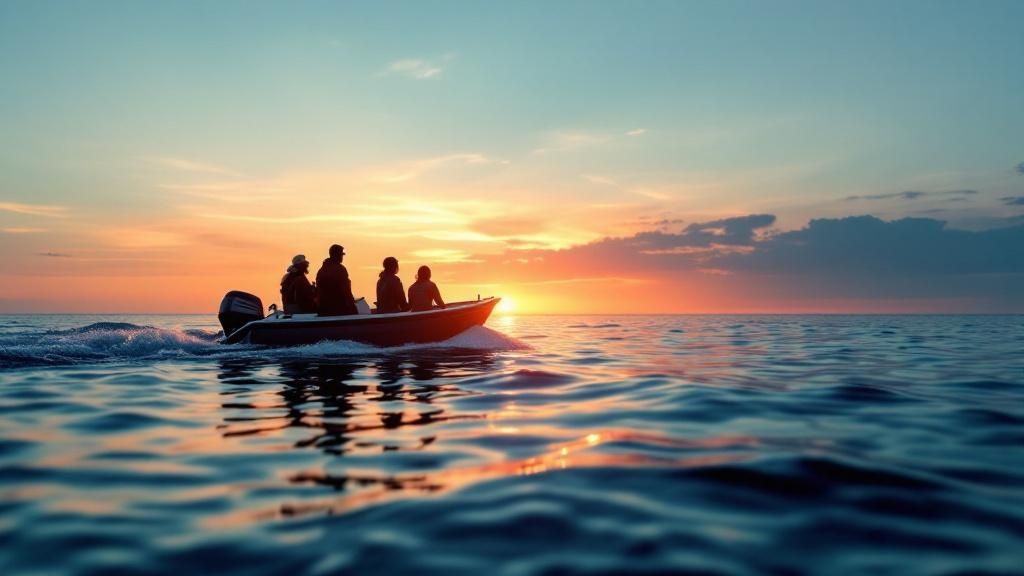
Alright, you've got the basics down. Now, let's talk about the little things that can take your whale watching trip from just "good" to absolutely unforgettable. Over the years, I've learned it’s the small details—like what you pack and what time you head out—that make all the difference.
This isn't just about showing up for a boat ride. It's about setting yourself up to fully soak in one of nature’s greatest shows. A little bit of prep means you'll be more comfortable, see more, and connect on a deeper level with the wild majesty unfolding in front of you.
Book a Morning Tour for the Best Conditions
If I can give you one golden nugget of advice, it's this: book a morning tour. Yes, afternoon trips can be amazing, but the morning consistently offers a set of advantages that really stack the deck in your favor.
Picture the ocean surface as a giant, clear window. Early in the day, that window is often glassy and smooth because the winds haven't kicked up yet. This makes spotting a distant spout, a dorsal fin, or the dark shadow of a whale just below the surface so much easier. As the day wears on, the wind usually picks up, creating that surface "chop" that can easily hide what you’re looking for.
Don't just take my word for it. Long-term volunteer whale counts show a clear pattern. The number of whales spotted around 8:00 a.m. is often 50% higher than at midday. This is largely thanks to those calm, clear conditions. For a deeper dive into the data, you can check out some fantastic insights gathered on the Big Island.
Your Essential Packing Checklist
Staying comfortable out on the water is non-negotiable. Even on a perfect, sunny Hawaiian day, the conditions at sea are a world away from what you feel on land. That light sea breeze feels surprisingly cool, and the sun reflecting off the water is way more intense than you’d think. Packing a small bag with a few key items ensures you’re focused on the whales, not on being cold or sunburnt.
Here’s my go-to checklist for what to bring:
- Polarized Sunglasses: These are a total game-changer. They slice right through the surface glare, letting you see deeper into the water and spot whales much more easily.
- Reef-Safe Sunscreen: The Hawaiian sun is no joke. Protect your skin—and our fragile coral reefs—by grabbing a mineral-based, reef-safe formula.
- A Light Jacket or Windbreaker: The wind can pick up out of nowhere. A light layer is perfect for when the temperature dips or a little spray comes over the bow.
- Camera with a Zoom Lens: Your phone is fine, but a real camera with a decent zoom will help you capture incredible details from a respectful distance.
- Binoculars: There's nothing like bringing a distant breach or tail slap into sharp, crystal-clear focus. A good pair of binoculars makes that happen.
Manage Expectations and Respect the Whales
Finally, and this might be the most important tip of all, remember to check your expectations at the dock. These aren't trained performers in a theme park; they are magnificent, wild animals in their own home. Their behavior is completely on their terms, which is precisely what makes every single sighting so incredibly special.
Good, responsible tour operators follow federal law, which requires them to stay at least 100 yards away from humpback whales. This isn't to spoil your fun; it’s to protect the animals and ensure we aren't disrupting their natural, crucial behaviors. So instead of wishing the boat could inch closer, take a moment to appreciate that your tour is respecting their space.
This respectful distance is your ticket to seeing the real show: a mother teaching her calf to breach, a group of males competing for a female, or a lone whale just peacefully logging at the surface. Trust your captain, relax, and just enjoy the profound privilege of being a guest in their ocean home.
A Field Guide to Humpback Whale Behaviors
When a humpback whale explodes from the ocean, it’s a moment that completely resets your understanding of power and grace. But to really appreciate what you’re seeing out there, you need to learn their language—a language spoken through incredible acrobatics and sound. This is what turns a simple sighting into a rich, unforgettable experience.
When you see these behaviors, you're not just watching random actions. You're getting a peek into their complex social world. Every splash, spout, and slap has a purpose, whether it's for communication, showing off for a mate, or maybe just pure, unadulterated joy. Understanding the "why" behind what they do connects you to these gentle giants on a much deeper level.
By learning to spot a few key behaviors, you go from being a spectator to feeling like a field naturalist. You start to see the story unfolding on the water—a drama of courtship, parenting, and survival that has played out in these very waters for centuries.
These amazing animals have made a truly remarkable comeback. Learning about how humpback whales were addressed on the endangered species list makes every single encounter feel that much more precious.
The Most Iconic Whale Behaviors
Out on the water, keep your eyes peeled for these breathtaking displays. Each one is a clue, a piece of the puzzle telling you what the whales are up to.
-
The Breach: This is the ultimate showstopper. It's when a 40-ton whale launches its entire body almost completely out of the water, crashing back down with a colossal splash you can hear from a mile away. Scientists have a few theories: it could be a long-distance signal, a way to shake off pesky skin parasites, or simply an expression of pure energy. Whatever the reason, it will leave you speechless.
-
The Tail Slap (Lobtailing): You'll see a whale raise its massive tail flukes high out of the water and smack them down hard against the surface. The sound it creates is a loud, resonating thwack that travels for miles underwater. Think of it as a clear warning, a way to show dominance, or just a method to get another whale's attention from across the channel.
-
The Pectoral Fin Slap: This is similar to the tail slap, but the whale rolls onto its side and repeatedly slaps its long pectoral fin on the water's surface. It’s another powerful form of communication, almost like someone clapping their hands to make a point or announce their presence.
Quieter Moments That Speak Volumes
Not all whale behavior is explosive and splashy. Some of the most meaningful encounters are the quiet, subtle ones that hint at the intelligence and curiosity of these animals.
One of the most captivating behaviors is the spyhop. This is when a whale positions itself vertically in the water, poking its head straight up and sometimes even exposing its eyes. Just like the name implies, it's getting a better look at what's going on above the surface—and that includes you and your tour boat! It's a moment of mutual curiosity that feels incredibly personal.
Another common sight is the blow, or spout. This is simply the whale exhaling with incredible force, shooting a plume of vapor and air up to 20 feet high. It's often the very first sign you'll get that a whale is nearby, a tell-tale puff on the horizon.
By learning to spot these behaviors, from the thunderous breach to the quiet spyhop, your whale watching adventure becomes an unforgettable conversation with the ocean's most magnificent residents.
Alright, you've got the timing down and you're dreaming of whale breaches. But a few practical questions might still be bubbling up as you get ready for your Big Island whale watching adventure. Let's clear those up so you can head out on the water feeling like a seasoned pro.
We get these questions all the time, so let's walk through the answers to make sure you're totally prepared for an incredible day.
Answering Your Top Concerns
Can I Really See Whales From The Shore?
You absolutely can! In fact, the Big Island has some of the best land-based whale watching in all of Hawaii. Just grab a good pair of binoculars, find a scenic perch along the Kohala Coast—the Puukohola Heiau National Historic Site is a fantastic spot—and get ready. With a little patience, you have an excellent chance of spotting those iconic breaches, tail slaps, and spouts right from the coastline.
Why Is Morning The Best Time For A Tour?
There's a reason every experienced guide pushes for a morning trip. It really comes down to two things. First, the ocean is almost always calmer, creating a glassy surface that makes spotting a distant spout or fin so much easier. The difference is huge—some research even shows that sightings can be up to 50% higher around 8:00 a.m. compared to midday, just because the visibility is better.
On top of that, the morning light is just gorgeous for photos, and the winds haven't had a chance to kick up yet. It all adds up to a more comfortable and rewarding experience on the water. It’s a win-win.
Do Tours Guarantee Whale Sightings?
Honestly, no reputable tour company should ever guarantee you'll see a wild animal. That said, because you're visiting during the absolute peak of the season, the odds are overwhelmingly in your favor. Most established tour operators have a great "rain check" policy: if for some reason the whales are shy that day and you don't see any, they'll offer you a free trip to try again.
What If I Get Seasick?
Don't let a sensitive stomach stop you from experiencing this! If you're worried about motion sickness, just plan ahead. A larger, more stable boat like a catamaran will make a huge difference. You can also take an over-the-counter motion sickness remedy before your tour, sip on water, and keep your eyes locked on the steady horizon.
Ready to witness the magic for yourself? At Kona Snorkel Trips, our expert, lifeguard-certified guides lead unforgettable small-group tours that bring you respectfully close to these magnificent animals. Book your adventure today and create memories that will last a lifetime.
